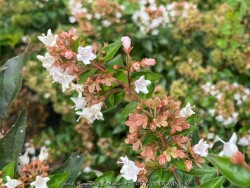

Raspberry Profusion Abelia (Abelia chinensis 'Raspberry Profusion') is a compact rounded, spreading, multi-stemmed shrub in the honeysuckle family. Typically grows on gracefully arching branches to 2-4' tall. 'Raspberry Profusion', a seedling selection of 'Edward Goucher' x chinensis, blooms heavily from May to September. The entire plant is covered with big clusters of strongly-scented, pink flowers with flamboyant raspberry sepals. The sepals remain after the flowers drop, extending the color until the end of autumn. New growth emerges glossy red and ages to a handsome dark green. The shrub is robust and compact, growing to 3-4' tall and wide. It is mostly deciduous in the winter. Semi-evergreen dark green leaves turn purplish-bronze in autumn persisting until 10 degrees F or so. Wood is hardy to 0 degrees F. In years where the stems die to the ground in winter but the plant survives, flowering will still occur on new growth. 'Raspberry Profusion' Abelia (Abelia chinensis 'Raspberry Profusion') is an unusually hardy abelia, thriving even in zone 5b. Abelia is also known for it's fragrant flowers that attract butterflies and hummingbirds, plus it's shade-tolerant and resistant to both deer and rabbits. Graceful, arching habit makes it a perfect choice for late season fragrance in your landscape.
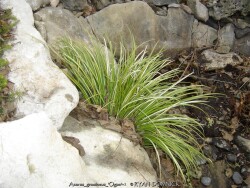

Golden Variegated Japanese Sweet Flag (Acorus gramineus 'Ogon') is a semi-evergreen marginal aquatic perennial. In constant wet conditions, it handles full-sun. It features a bright greenish-yellow grass-like tufts of narrow leaf blades. It is native to wetland areas of China, Japan, Korea, India, Thailand, Myanmar and the Philippines. In Kansas, it is very useful as a reliable rain garden plant or average garden plant in soils that do not dry out in full to part shade. Also useful on north walls and areas without tree-root competition. It cannot handle prolonged Kansas droughts or dry-shade. Foliage will flatten to the ground during brief drought then spring back up when moisture is available again. In Eastern Kansas, typically our 40 inches of rainfall is sufficient without extra water if planted in good soils. Generally however, in non-irrigated areas with poor soil, this plant will decline and allow weeds to invade. Foliage is evergreen (bright chartreuse-green) down to -5 to -10 degrees F offering valuable winter color.
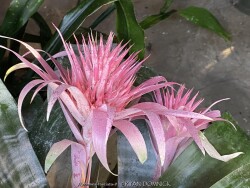

Silver Vase / Urn Plant (Aechmea fasciata) is an exotic-looking flowering plant from the bromeliad (Bromeliaceae) family. Despite its exotic appearance and tropical nature, this bromeliad adapts well to living as a potted house plant. In Kansas, use as a summer patio plant and protect from direct sunlight in mid summer and any temperatures below 50 degrees F in the spring or fall. As an epiphyte, much of its water needs are met by keeping the plants center "Urn" filled with water once per week or two. They have a shallow root systems and probably won't ever need repotted. When flowering, the flowers themselves are short-lived, but the pink and red bracts last for a few months.
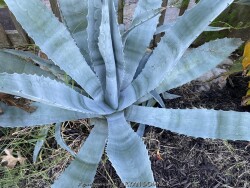

Powder Blue leaves from this agave (Agave americana) make an excellent architectural statement. Used as a patio plant in Kansas, place in full sun with no extra watering except from rainfall. Repotting may or may not be needed depending on how large you want the plant to grow. Potted plants are hardy to at least 20 degrees F if kept dry so you can wait awhile to move these in for the winter. Then move into a cold garage, basement, or window over the winter with NO watering. Luckily monocarpic flowering will never occur in a potted agave so you don't have to worry about death after flowering. A suggestion to make this plant a lot more safe around your eyeballs is to clip the new spines off as the new leaves slowly unfurl. As a winter-only house plant, it will look presentable all winter long with just no waterings. As a permanent house plant, provide bright light and allow the soil to dry between waterings for many years of carefree enjoyment.


Powder Blue leaves from this agave (Agave havardiana) make an excellent architectural statement. Used as a patio plant in Kansas, place in full sun with no extra watering except from rainfall. Repotting may or may not be needed depending on how large you want the plant to grow. Potted plants are hardy to at least 0-5 degrees F if kept dry so you can wait awhile to move these in for the winter. Then move into a cold garage, basement, or window over the winter with NO watering. Luckily monocarpic flowering will never occur in a potted agave so you don't have to worry about death after flowering. A suggestion to make this plant a lot more safe around your eyeballs is to clip the new spines off as the new leaves slowly unfurl. Although un-tested by the author, this agave could survive in a microclimate under a south facing roof overhang kept completely dry in the winter and controlled water in the summer. As a winter-only house plant, it will look presentable all winter long with just no waterings. As a permanent house plant, provide bright light and allow the soil to dry between waterings for many years of carefree enjoyment. We are testing this outside in our crevice garden among other hardy cacti and succulents! We will keep you posted. (2024)


Powder Blue leaves from this agave (Agave parryi var. couesii) make an excellent architectural statement. Used as a patio plant in Kansas, place in full sun with no extra watering except from rainfall. Repotting may or may not be needed depending on how large you want the plant to grow. Potted plants are hardy to at least 0-5 degrees F if kept dry so you can wait awhile to move these in for the winter. Then move into a cold garage, basement, or window over the winter with NO watering. Luckily monocarpic flowering will never occur in a potted agave so you don't have to worry about death after flowering. A suggestion to make this plant a lot more safe around your eyeballs is to clip the new spines off as the new leaves slowly unfurl. Although un-tested by the author, this agave could survive in a microclimate under a south facing roof overhang kept completely dry in the winter and controlled water in the summer. A planting in Stillwater Oklahoma has survived 20 years on an exposed sandstone retaining wall and endured temperatures as low as negative 19 F one winter and a week of negative night temperatures in 2021 with some foliage damage. As a winter-only house plant, it will look presentable all winter long with just no waterings. As a permanent house plant, provide bright light and allow the soil to dry between waterings for many years of carefree enjoyment. An large established potted plant in our Lawrence, KS (zone 6a) cold frame survived 0 degrees F for a couple days and lows in the single digits or teens for a week. It was kept dry but with no mulch or protection, accidentally being left on a raised greenhouse bench. It appeared frozen solid with a leaf breaking off and ice crystals visible! Amazingly, absolutely no damage occured when it thawed; must be filled with some kind of natural antifreeze or stretchy cell walls!
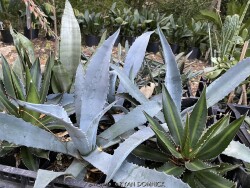

Powdery Blue leaves from agave make an excellent architectural statement. Used as a patio plant in Kansas, place in full sun with no extra watering except from rainfall. Repotting may or may not be needed depending on how large you want the plant to grow. Potted plants are hardy to at least 20 degrees F if kept dry so you can wait awhile to move these in for the winter. Then move into a cold garage, basement, or window over the winter with NO watering. Luckily monocarpic flowering will never occur in a potted agave so you don't have to worry about death after flowering. A suggestion to make this plant a lot more safe around your eyeballs is to clip the new spines off as the new leaves slowly unfurl. As a winter-only house plant, it will look presentable all winter long with just no waterings. As a permanent house plant, provide bright light and allow the soil to dry between waterings for many years of carefree enjoyment.


Wide crooked spines and plump fat leaves make this agave (Agave titanota) unique while making an excellent architectural statement. Used as a patio plant in Kansas, place in full sun with no extra watering except from rainfall. Repotting may or may not be needed depending on how large you want the plant to grow. Potted plants are hardy to at least 30 degrees F if kept dry. Move it in before first frost to play it safe especially if the plant is plump and well watered. Move into a cold garage, basement, or window over the winter with NO watering. Luckily monocarpic flowering will never occur in a potted agave so you don't have to worry about death after flowering. A suggestion to make this plant a lot more safe around your eyeballs is to clip the new spines off just slightly enough to not ruin the architectural effect as the new leaves slowly unfurl. As a winter-only house plant, it will look presentable all winter long with just no waterings. As a permanent house plant, provide bright light and allow the soil to dry between waterings for many years of carefree enjoyment.


This hardy agave came to us from Yucca Pointe Nursery in Stillwater, OK where it grows outside in the owner Nathan Priest's display garden. (Agave toumeyana) make an excellent architectural statement. Used as a patio plant in Kansas, place in full sun with no extra watering except from rainfall. Repotting may or may not be needed depending on how large you want the plant to grow. Potted plants are hardy to at least 15 degrees F if kept dry so you can wait awhile to move these in for the winter. Then move into a cold garage, basement, or window over the winter with NO watering. Luckily monocarpic flowering will never occur in a potted agave so you don't have to worry about death after flowering. A suggestion to make this plant a lot more safe around your eyeballs is to clip the new spines off as the new leaves slowly unfurl. Although un-tested in Lawrence, KS (zone 6a), this agave could survive in a microclimate under a south facing roof overhang kept completely dry in the winter and controlled water in the summer. As a winter-only house plant, it will look presentable all winter long with just no waterings. As a permanent house plant, provide bright light and allow the soil to dry between waterings for many years of carefree enjoyment. We are testing this outside in our crevice garden among other hardy cacti and succulents! We will keep you posted. (2024)
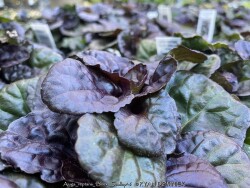

Ajugas are extremely hardy groundcovers that quickly form a dense carpet-like mat. Unlike many perennials that are grown only for their flowers, Ajuga is prized for its attractive, evergreen colorful foliage that looks nice all year. The deepest foliage color is achieved when plants are sited in full sun and in cooler temperatures although in Kansas this may result in foliage burning in summer if not adequately watered. From mid to late spring, short deep blue flower spikes stand upright above the foliage. Do not allow foliage to be covered with leaves or mulch during winter or crown rot disease may occur wiping out large patches. Ajuga reptans 'Black Scallop' tends to spread more slowly and stay naturally compact compared to other varieties of Ajuga, making it suitable for use as an edging, rock gardens, walking trails borders and mixed container plantings. This attractive small-scale variety has glossy, near-black, scalloped leaves and a dense habit.
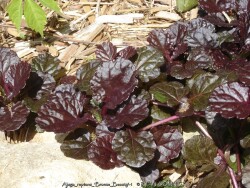

Ajugas are extremely hardy groundcovers that quickly form a dense carpet-like mat. Unlike many perennials that are grown only for their flowers, Ajuga is prized for its attractive, evergreen colorful foliage that looks nice all year. The deepest foliage color is achieved when plants are sited in full sun and in cooler temperatures although in Kansas this may result in foliage burning in summer if not adequately watered. From mid to late spring, short deep blue flower spikes stand upright above the foliage. Do not allow foliage to be covered with leaves or mulch during winter or crown rot disease may occur wiping out large patches. Ajuga reptans 'Bronze Beauty' tends to spread more slowly and stay naturally compact compared to other varieties of Ajuga, making it suitable for use as an edging, rock gardens, walking trails borders and mixed container plantings. This attractive small-scale variety has glossy, purplish-black, shiny leaves and a dense habit.
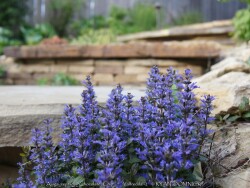

Ajugas are extremely hardy groundcovers that quickly form a dense carpet-like mat. Unlike many perennials that are grown only for their flowers, Ajuga is prized for its attractive, evergreen colorful foliage that looks nice all year. The deepest foliage color is achieved when plants are sited in full sun and in cooler temperatures although in Kansas this may result in foliage burning in summer if not adequately watered. From mid to late spring, short deep blue flower spikes stand upright above the foliage. Do not allow foliage to be covered with leaves or mulch during winter or crown rot disease may occur wiping out large patches. Ajuga reptans 'Chocolate Chip' / 'Valfredda' is the smallest and tends to spread more slowly and stay naturally compact compared to other varieties of Ajuga, making it suitable for use as an edging, rock gardens, walking trails borders and mixed container plantings. This attractive small-scale variety has tiny carpetlike purple leaves and a dense habit.


Ajugas are extremely hardy groundcovers that quickly form a dense carpet-like mat. Unlike many perennials that are grown only for their flowers, Ajuga is prized for its attractive, evergreen colorful foliage that looks nice all year. The deepest foliage color is achieved when plants are sited in full sun and in cooler temperatures although in Kansas this may result in foliage burning in summer if not adequately watered. From mid to late spring, short deep blue flower spikes stand upright above the foliage. Do not allow foliage to be covered with leaves or mulch during winter or crown rot disease may occur wiping out large patches. Ajuga reptans 'Chocolate Chip' / 'Valfredda' is the smallest and tends to spread more slowly and stay naturally compact compared to other varieties of Ajuga, making it suitable for use as an edging, rock gardens, walking trails borders and mixed container plantings. This attractive small-scale variety has tiny carpetlike purple leaves and a dense habit.


Five leaf Akebia (Akebia quinata) is a twining vine with green leaves arranged in a palmate shape. Maroon to purple flowers have the slight aroma of chocolate and bloom early in the spring. As with most vines, they are not low maintenance due to their nature and purpose in life. Vines by nature are kind of like freeloaders that want to use other things (and other plants) for free support. This does not directly parasitize the tree but can add a lot of weight (storm damage) and shade out it's foliage. It requires training to grow on some structures but will generally twine and try to grow to the highest point possible. When properly trained on a trellis or pergola, akebia can be amazing. It will grow in just about any soil and tolerate full shade to full sun. It may be used as a groundcover if nothing to climb on or an edible plant if you pollinate the flowers by hand. There are varieties available that when crossed, produce edible fruit. Akebia is invasive in some parts of the country but this is not the case in Kansas. Blooms occur in march or april very early when frosts are still occurring but with little damage to the plant. Foliage is persistent and semi evergreen until 10-15 degrees F.
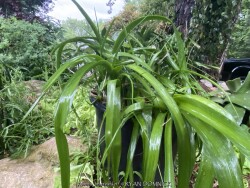

Pregnant Onion (Albuca bracteata) is typically grown in warmer zones. Considered a tropical or succulent in Kansas and used as summer patio plants with white flowers and bright green foliage. Be prepared to give away offset bulblets to all your friends! Water sparingly and place in full sun to mostly shade. Pregnant Onion can tolerate frost but protect from temperatures below 25 degrees F and move into a cold garage or basement over the winter with minimal watering. Do not allow the pot with rootball to freeze solid or go below 23 degrees for more than a few hours. Allow to go dormant with little care, just cut off dead foliage and place back out in April or May with a time-release fertilizer. Repotting may or may not be needed depending on how large you want the plant to grow; plants can continue to grow taller and tolerate extremely root-bound pots but may need wind bracing. If repotting, make sure to use a sharp draining medium organic cactus mix with plenty of sand and perlite.
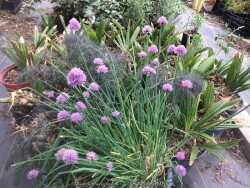

Chives (Allium schoenoprasum) are an easy to grow edible and ornamental perennial. Attractive, globular, clover-like clusters of pale purple flowers appear in spring and early summer. Grow in just about any soil including heavy clay in full to part sun. In Eastern Kansas, typically our 40 inches of rainfall is sufficient without extra water. And as with all alliums, these are completely rabbit proof. Considered a "Once it's there, it's there forever" plant!


***Description for this perennial available with future update!***
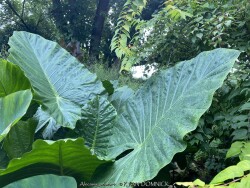

Odora Elephant Ear (Alocasia odora) is typically grown in warmer zones and features giant glossy green leaves creating quite a contrast for other colorful flowers in the garden. Most alocasia are large tropical and subtropical herbaceous perennials with a giant tubers native to areas with a summer monsoon and dry winter. Along with other tropicals and succulents in Kansas, elephant ears are usually grown as summer patio plants. Fertilize, water regularly, and place in full sun. Protect from temperatures below 28 degrees F and move into a cold garage or basement over the winter with minimal watering. Do not allow the pot with rootball to freeze solid or go below 25 degrees for more than a few hours. Allow to go dormant as needed with little care, just cut off dead foliage and place back out in April or May with a time-release fertilizer. Many plants will die back slowly and remain attractive inside for most of the winter. You may also plant these in the ground for an enormous tropical effect! It is possible to overwinter these in the ground in Kansas by placing a giant 12-18" mound of mulch over deeply planted rhizomes. New growth will usually be delayed until June but quickly regains full height. In our trial gardens in Lawrence, KS (zone 6a), three established specimens planted over 12" deep and mulched 6-12" with leaf mulch survived -17 degrees F. During the arctic blast of February, 2021, lows down to -17 degrees F on Feb 16th, 2021 were recorded. The longevity of this cold blast was also impressive: 10 days on a row with highs of 10-15 degrees F or lower, 8 nights of lows in the single digits and negatives, and 36 strait hours of 0 degrees F and mostly lower.
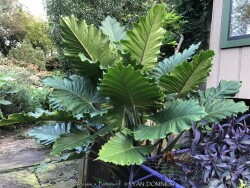

Portora Elephant Ear (Alocasia x Portora) is typically grown in warmer zones and features giant glossy green leaves creating quite a contrast for other colorful flowers in the garden. Most alocasia are large tropical and subtropical herbaceous perennials with a giant tubers native to areas with a summer monsoon and dry winter. Along with other tropicals and succulents in Kansas, elephant ears are usually grown as summer patio plants. Fertilize, water regularly, and place in full sun. Protect from temperatures below 28 degrees F and move into a cold garage or basement over the winter with minimal watering. Do not allow the pot with rootball to freeze solid or go below 25 degrees for more than a few hours. Allow to go dormant as needed with little care, just cut off dead foliage and place back out in April or May with a time-release fertilizer. Many plants will die back slowly and remain attractive inside for most of the winter. You may also plant these in the ground for an enormous tropical effect! It is possible to overwinter these in the ground in Kansas by placing a giant 12-18" mound of mulch over deeply planted rhizomes. New growth will usually be delayed until June but quickly regains full height. This plant can also grow in standing water or as a potted plant in water gardens.


***Description for this plant available with future update!*** Cacti are known for their spines, unusual shapes and beautiful flowers. Both succulents and cacti store water in their fleshy tissues. And can survive long periods without water. Cacti and succulents are usually grown as a deck/patio plant or house plant in Kansas. Grow in full sun with little to no extra watering except that which comes from rainfall. Generally, plants may be brought out in Late May through Early October in our zone 6a Lawrence, KS climate. To play is safe, potted plants are best moved in before autumn leaves begin to drop and before night temperatures get below 45 degrees F. It is very important to avoid the combination of wet and cold. Move to a bright interior window over the winter with little to no watering and keep above 50 degrees F. As a winter house plant, it will look presentable all winter long with little to no waterings. As a permanent house plant, provide bright light and allow the soil to dry completely between waterings and you will get many years of carefree enjoyment. Plants grown permanently indoors may eventually begin to elongate stretching for light and lose their spine color. It can be hard to reproduce the intense UV sunlight they need when growing indoors so moving outside for the summer is best. Generally if moving outside for the summer, allow 1-2 weeks of part shade or morning sun before placing in full sun. Plants with time to acclimate will thrive in full sun but be careful not to rush it or sunburning may occur. Repotting may or may not be needed depending on how large you want the plant to grow; plants can continue to grow taller and tolerate extremely root-bound pots but may need wind bracing. If repotting, make sure to use a sharp draining low organic cactus mix with plenty of sand and perlite but avoid peat moss. The “soil” most commercial cacti are potted in to too peaty and light weight. This soil becomes hydrophobic and shrinks after becoming bone dry and difficult to re wet again. Cacti never grow in peat-based soils in nature; this “Soil” is only good for shipping because of the light weight. Potted plants are very low maintenance but watch for scale and mealybugs that may hide beneath the cover of spines. The best pest removal approach is to periodically wash the cactus off. Achieve this with a water nozzle or hose breaker turned mostly off to increase the pressure from the blast of water. This high-pressured water kills the pests without damaging the thick cactus skin. Here are some little-known or rare factoids about cacti: 1. The "spines" are actually modified leaves filled with sap at first, then quickly drying out to form the spines! 2. Many cacti have bright colored flowers that mainly attract bees, while some tubular flowering types attract hummingbirds and bats. 3. Late on the evolutionary timeline, cacti fossils are rare to non-existent. Cacti are native almost exclusively to the Americas, while succulents can include a much larger plant palette be from any dry area in the world. 4. Some cactus plants have been known to survive more than 2 years without water. 5. Some cacti first evolved in a dry climate that later became wetter again. For example: several jungle species live as epiphytes in trees to achieve the fast drainage they need.


***Description for this plant available with future update!*** Cacti are known for their spines, unusual shapes and beautiful flowers. Both succulents and cacti store water in their fleshy tissues. And can survive long periods without water. Cacti and succulents are usually grown as a deck/patio plant or house plant in Kansas. Grow in full sun with little to no extra watering except that which comes from rainfall. Generally, plants may be brought out in Late May through Early October in our zone 6a Lawrence, KS climate. To play is safe, potted plants are best moved in before autumn leaves begin to drop and before night temperatures get below 45 degrees F. It is very important to avoid the combination of wet and cold. Move to a bright interior window over the winter with little to no watering and keep above 50 degrees F. As a winter house plant, it will look presentable all winter long with little to no waterings. As a permanent house plant, provide bright light and allow the soil to dry completely between waterings and you will get many years of carefree enjoyment. Plants grown permanently indoors may eventually begin to elongate stretching for light and lose their spine color. It can be hard to reproduce the intense UV sunlight they need when growing indoors so moving outside for the summer is best. Generally if moving outside for the summer, allow 1-2 weeks of part shade or morning sun before placing in full sun. Plants with time to acclimate will thrive in full sun but be careful not to rush it or sunburning may occur. Repotting may or may not be needed depending on how large you want the plant to grow; plants can continue to grow taller and tolerate extremely root-bound pots but may need wind bracing. If repotting, make sure to use a sharp draining low organic cactus mix with plenty of sand and perlite but avoid peat moss. The “soil” most commercial cacti are potted in to too peaty and light weight. This soil becomes hydrophobic and shrinks after becoming bone dry and difficult to re wet again. Cacti never grow in peat-based soils in nature; this “Soil” is only good for shipping because of the light weight. Potted plants are very low maintenance but watch for scale and mealybugs that may hide beneath the cover of spines. The best pest removal approach is to periodically wash the cactus off. Achieve this with a water nozzle or hose breaker turned mostly off to increase the pressure from the blast of water. This high-pressured water kills the pests without damaging the thick cactus skin. Here are some little-known or rare factoids about cacti: 1. The "spines" are actually modified leaves filled with sap at first, then quickly drying out to form the spines! 2. Many cacti have bright colored flowers that mainly attract bees, while some tubular flowering types attract hummingbirds and bats. 3. Late on the evolutionary timeline, cacti fossils are rare to non-existent. Cacti are native almost exclusively to the Americas, while succulents can include a much larger plant palette be from any dry area in the world. 4. Some cactus plants have been known to survive more than 2 years without water. 5. Some cacti first evolved in a dry climate that later became wetter again. For example: several jungle species live as epiphytes in trees to achieve the fast drainage they need.
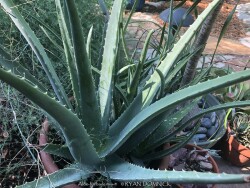

Giant Aloe is typically grown in warmer zones. Considered a tropical or succulent in Kansas and used as summer patio plants with white flowers and bright green foliage. Be prepared to give away offsets to all your friends! Water sparingly and place in mostly shade followed by full sun after acclimated. Giant Aloe can tolerate frost but protect from temperatures below 25 degrees F and move into a cold garage or basement over the winter with minimal watering. Do not allow the pot with rootball to freeze solid or go below 25 degrees for more than a few hours. It is important to avoid the combination of wet and cold. As a winter house plant, it will look presentable all winter long with just no waterings. As a permanent house plant, provide bright light and allow the soil to dry between waterings for many years of carefree enjoyment. Plants grown permanently indoors may begin to elongate stretching for light producing weak new growth. It can be hard to reproduce the intense UV sunlight they need so moving outside for the summer is best.Generally if moving outside for the summer, allow 3-4 weeks of part shade or morning sun before placing in full sun. Giant aloe is one of the slowest plants to re-acclimate to bright sunlight so this might take a month or so of protecting from full sun. Potted plants are very low maintenance. Division and re-potting will need to eventually occur as plants will get top heavy and offsets will fall out. I have never seen any insect problems on this plant. Survives each year a a long lasting annual in out display garden until about 18-20 degrees...usually into December before it looks damaged and unsightly.


***Description for this plant available with future update!*** Cacti are known for their spines, unusual shapes and beautiful flowers. Both succulents and cacti store water in their fleshy tissues. And can survive long periods without water. Cacti and succulents are usually grown as a deck/patio plant or house plant in Kansas. Grow in full sun with little to no extra watering except that which comes from rainfall. Generally, plants may be brought out in Late May through Early October in our zone 6a Lawrence, KS climate. To play is safe, potted plants are best moved in before autumn leaves begin to drop and before night temperatures get below 45 degrees F. It is very important to avoid the combination of wet and cold. Move to a bright interior window over the winter with little to no watering and keep above 50 degrees F. As a winter house plant, it will look presentable all winter long with little to no waterings. As a permanent house plant, provide bright light and allow the soil to dry completely between waterings and you will get many years of carefree enjoyment. Plants grown permanently indoors may eventually begin to elongate stretching for light and lose their spine color. It can be hard to reproduce the intense UV sunlight they need when growing indoors so moving outside for the summer is best. Generally if moving outside for the summer, allow 1-2 weeks of part shade or morning sun before placing in full sun. Plants with time to acclimate will thrive in full sun but be careful not to rush it or sunburning may occur. Repotting may or may not be needed depending on how large you want the plant to grow; plants can continue to grow taller and tolerate extremely root-bound pots but may need wind bracing. If repotting, make sure to use a sharp draining low organic cactus mix with plenty of sand and perlite but avoid peat moss. The “soil” most commercial cacti are potted in to too peaty and light weight. This soil becomes hydrophobic and shrinks after becoming bone dry and difficult to re wet again. Cacti never grow in peat-based soils in nature; this “Soil” is only good for shipping because of the light weight. Potted plants are very low maintenance but watch for scale and mealybugs that may hide beneath the cover of spines. The best pest removal approach is to periodically wash the cactus off. Achieve this with a water nozzle or hose breaker turned mostly off to increase the pressure from the blast of water. This high-pressured water kills the pests without damaging the thick cactus skin. Here are some little-known or rare factoids about cacti: 1. The "spines" are actually modified leaves filled with sap at first, then quickly drying out to form the spines! 2. Many cacti have bright colored flowers that mainly attract bees, while some tubular flowering types attract hummingbirds and bats. 3. Late on the evolutionary timeline, cacti fossils are rare to non-existent. Cacti are native almost exclusively to the Americas, while succulents can include a much larger plant palette be from any dry area in the world. 4. Some cactus plants have been known to survive more than 2 years without water. 5. Some cacti first evolved in a dry climate that later became wetter again. For example: several jungle species live as epiphytes in trees to achieve the fast drainage they need.
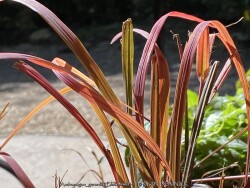

Big Bluestem (Andropogon gerardii 'Blackhawks') is easily grown in average, dry to medium, well-drained soils in full sun. It is tolerant of a wide range of soils and growing conditions but tends to flop in rich moist soils. This ornamantal grass is a tall, Kansas native, perennial, warm season grass that dominates much of the tall grass prairie extending into the Flint Hills. In fact, Big bluestem, Indiangrass, Little bluestem, and Switchgrass comprise 75% of the species in this ecosystem. It may be grown as an ornamental grass because of its attractive foliage which changes color seasonally along with its good architectural height and its interesting flower/seed heads. Andropogon gerardii 'Blackhawks' is primarily distinguished from the species by its slightly shorter height, deeper green summer foliage and blackish-purple fall color. An excellent garden performer with a clumping form and upright habit. Leaves emerge deep green with red highlights in spring, remain green through much of the summer, change to purplish-red to purple by late summer and finally turn a vivid scarlet red after first fall frost. Burgundy purple flowers bloom in August. Plants typically grow to 4-5' tall.


Big Bluestem (Andropogon gerardii 'Red October') is easily grown in average, dry to medium, well-drained soils in full sun. It is tolerant of a wide range of soils and growing conditions but tends to flop in rich moist soils. This ornamantal grass is a tall, Kansas native, perennial, warm season grass that dominates much of the tall grass prairie extending into the Flint Hills. In fact, Big bluestem, Indiangrass, Little bluestem, and Switchgrass comprise 75% of the species in this ecosystem. It may be grown as an ornamental grass because of its attractive foliage which changes color seasonally along with its good architectural height and its interesting flower/seed heads. Andropogon gerardii 'Red October' is primarily distinguished from the species by its slightly shorter height, deeper green summer foliage and brilliant scarlet red fall color. An excellent garden performer with a clumping form and upright habit. Leaves emerge deep green with red highlights in spring, remain green through much of the summer, change to purplish-red to purple by late summer and finally turn a vivid scarlet red after first fall frost. Burgundy red flowers bloom in August. Plants typically grow to 4-5' tall.
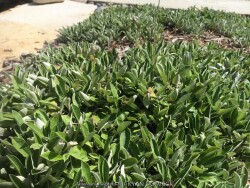

Pussytoes (Antennaria neglecta) are also known for their soft, silvery basal leaves, which spread to form a low groundcover in dry areas. Weeds have a hard time colonizing this groundcover in dry poor soil areas. Absolutely avoid planting pussytoes in moist soils or areas that have poor drainage or death will quickly occur. Native habitat across much of the Midwest and Northeast includes medium to dry black soil prairies, clay prairies, open woodlands and dry meadows. In Kansas landscapes, use as a retaining wall rock garden plant, a stepable groundcover along path, or in-between stepping stones in gravely well drained soils. Pussytoes is named for its white tufted flowers that look like tiny cat's feet. Flowers are interesting but generally best to cut before seed set as they detract from the tidy mat-like foliage. Antennaria neglecta has tiny foliage.
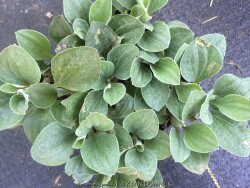

Pussytoes (Antennaria parlinii) are also known for their soft, silvery basal leaves, which spread to form a low groundcover in dry areas. Weeds have a hard time colonizing this groundcover in dry poor soil areas. Absolutely avoid planting pussytoes in moist soils or areas that have poor drainage or death will quickly occur. Native habitat across much of the Midwest and Northeast includes medium to dry black soil prairies, clay prairies, open woodlands and dry meadows. In Kansas landscapes, use as a retaining wall rock garden plant, a stepable groundcover along path, or in-between stepping stones in gravely well drained soils. Pussytoes is named for its white tufted flowers that look like tiny cat's feet. Flowers are interesting but generally best to cut before seed set as they detract from the tidy mat-like foliage. Antennaria parlinii has larger foliage and is more shade tolerant; a great plant for dry-shade.
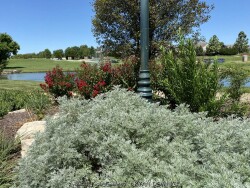

Powis Castle Artemisia (Artemisia 'Powis Castle') beautiful drought tolerant woody perennial valued for its finely dissected, aromatic, silver-gray foliage. It is evergreen down to 0 degrees F, if colder than -5degrees F, woody growth dies back too. Flowering is non-existant. As a perfect companion to vibrant flowering plants and ornamental grasses, it adds unique contrasting color and texture to waterwise landscapes. Most artemisias are best grown in poor to moderately fertile, dry to medium moisture, well-drained soils in full sun. In order to avoid occasional winter-kill in Kansas landscapes, it is advisable to plant on a south, east or west side of house or on south facing slopes or berms. Excellent soil drainage is essential for growing this plant well as poor lanky growth and root rot will occur in moist to wet soils. Tolerant of part-shade if kept dry. Cut back to 3-6" in early spring after dried winter silvery foliage stops looking attractive. New growth will emerge from the crown in mid-spring. If low temperatures hit -10 degrees F, it may kill an un-mulched plant; protect any zone 6 perennial with thick layer of mulch. General foliage decline may occur in hot and humid summer climates of the Southeast US but this is rarely a problem in Kansas or Oklahoma.
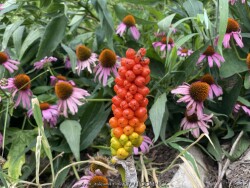

Italian Painted Arum (Arum italicum 'Pictum') is native to the Mediterranean region. It has a reversed or off-schedule life cycle; growing when other plants have already shed their leaves to take advantage of sunlight and lack of competition. It is often planted for its unusual evergreen leaf pattern and color resembling a bright green house plant growing outside in winter. Foliage goes dormant by June but is followed by naked stalks emerging from the ground with reddish orange berries. Foliage re-appears in fall and lasts well into winter untouched. If low temperatures hit 0 degrees F, foliage finally dies back to the ground and re-emerges in early spring to repeat the life cycle. If low temperatures hit -15 degrees F, it may kill an un-mulched plant; protect any zone 5/6 perennial with a 2-3" thick layer of mulch. Grow in average to rich well drained garden soil in full sun or full shade with everything in between. Moderate dry shade does not seem to be a problem because arum goes dormant anyways in the heat of summer. This holds true for planting in sunny locations to. Combine with shade garden plants that will fill the space in summer such as hostas or solomon seal. Also great when combined with late-emerging spring perennials (like plumbago, hardy hibiscus, and orange butterfly weed) because it fills that early spring space starting to grow extremely early with freeze-resistant foliage. Then later in the summer when Arum goes dormant, these plants hide the dying foliage and void left in the garden; what a great way for two species to share the same garden space! It has potential to be invasive in parts of the country such as the Pacific Northeast USA but not in Kansas. It is very stable but does not self-seed or spread in Lawrence, KS gardens; bulb offsets develop but only thicken the existing clump over time. Considered to be a great permatanet multi-season perennial for your garden.


Arundinaria gigantea is also called Canebrake (a tall thicket of any of a variety of Arundinaria) This species, along with its shorter form, 'Tecta', are the only bamboos native to the United States. It once covered huge swaths of rich bottomland along stream valleys and ravines throughout the southeastern United States but have been widely replaced by agriculture. Although still seen in small patches, it can reproduce asexually and rapidly. This adaptation that allows them to persist quietly in the shade of a forest for years and rapidly take advantage of disturbance which disrupts the overstory, such as blowdowns, floods or hurricanes. As a landscape plant, use the same as you would use oriental bamboo in large areas for a evergreen noise, wind, visual screening. Foliage is evergreen to 0 to 5 degrees F. Canes will defoliate at -5 to -10 degrees F. Canes die to the ground at -10 to -15 degrees. Root system will survive up to -25 to -30 degrees F as a perennial especially if mulched. Arundinaria gigantea usually grows 10-15' feet tall in Kansas. Every few years a grove will experience complete winterkill: it is strongly advised to cut all dead growth to the ground for aesthetic reasons and and fire prevention. The 'Tecta' form looks similar but only grows 6-8 feet tall and is tolerant of wet soil.
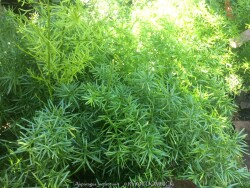

***Description for this plant available with future update!***
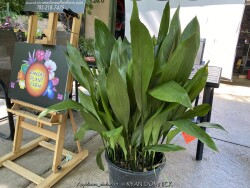

Cast-iron Plant (Aspidistra elatior) is a beautiful perennial and warmer climates for full shade. The leaves are glossy green perched on narrow stems with fat leaf blades. Unfortunately in our zone 6 Kansas climate, they cannot reliably be used as a perennial here. Most broadleaf evergreen plants are difficult to push the envelope with colder zones because evergreen leaves are more expensive to replace than for deciduous plants. (slower and requires more energy from the plant) Evergreen leaves are not intended to have to be replaced every year. In my father's zone 7a Stillwater Oklahoma garden, Cast-iron Plant can reliably be used as a perennial there but are dwarfed to about 1/2 size of normal. Anywhere south of zone 7b, count on it as a bullet-proof evergreen perennial! As a potted patio plant for full shade, they are wonderful. Grown in a raised pot, they are hardy to about 15-20° so you may be able to miss the first few frosts when moving them in for the winter. Before extreme cold (lower than 10 degrees F), they must be moved and overwintered in a dark garage or basement with monthly watering or bright window as a winter-only houseplant. Either way, they will hold up very well in the winter and maintain attractive foliage. When grown as a permanent house plant, they will last many years is grown in a bright indirect area. When Cast-iron Plant is grown as a permanent houseplant, you will need to watch for spider mites and possibly scale after a few years. Taking the whole plant outside and spraying with water a few times a year will help. Spider mites thrive and dry dusty conditions with low humidity (such as your house). Overall, Cast-iron Plants are very easy to grow hence their name. They will tolerate lower light than just about any house plant but after a few years, even this plant will decline unless given a summer growing season under a shaded tree or brighter conditions inside the house. New leaves grow about once per year and gradually the plant will need to be repotted as it is possible for them to split the container. This is a great time to divide the root system and get several new plants. This is one of our all-time favorite house plants.
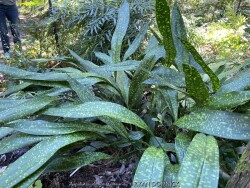

Cast-iron Plant (Aspidistra sp.) is a beautiful perennial and warmer climates for full shade. The leaves are glossy green perched on narrow stems with fat leaf blades. Unfortunately in our zone 6 Kansas climate, they cannot reliably be used as a perennial here. Most broadleaf evergreen plants are difficult to push the envelope with colder zones because evergreen leaves are more expensive to replace than for deciduous plants (slower and requires more energy from the plant). As a potted patio plant for full shade, they are wonderful. Grown in a raised pot, they are hardy to about 20-25° so you may be able to miss the first few frosts when moving them in for the winter. Before extreme cold (lower than approx.15 degrees F), they must be moved and overwintered in a dark garage or basement with monthly watering or bright window as a winter-only houseplant. Either way, they will hold up very well in the winter and maintain attractive foliage. When grown as a permanent house plant, they will last many years is grown in a bright indirect area. When Cast-iron Plant is grown as a permanent houseplant, you will need to watch for spider mites and possibly scale after a few years. Taking the whole plant outside and spraying with water a few times a year will help. Spider mites thrive and dry dusty conditions with low humidity (such as your house). Overall, Cast-iron Plants are very easy to grow hence their name. They will tolerate lower light than just about any house plant but after a few years, even this plant will decline unless given a summer growing season under a shaded tree or brighter conditions inside the house. New leaves grow about once per year and gradually the plant will need to be repotted as it is possible for them to split the container. This is a great time to divide the root system and get several new plants. This is one of our all-time favorite house plants.
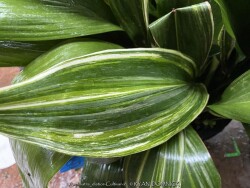

Cast-iron Plant (Aspidistra elatior cultivars) is a beautiful perennial and warmer climates for full shade. The leaves are glossy green perched on narrow stems with fat leaf blades. Unfortunately in our zone 6 Kansas climate, they cannot reliably be used as a perennial here. Most broadleaf evergreen plants are difficult to push the envelope with colder zones because evergreen leaves are more expensive to replace than for deciduous plants (slower and requires more energy from the plant). As a potted patio plant for full shade, they are wonderful. Grown in a raised pot, they are hardy to about 15-20° so you may be able to miss the first few frosts when moving them in for the winter. Before extreme cold (lower than 10 degrees F), they must be moved and overwintered in a dark garage or basement with monthly watering or bright window as a winter-only houseplant. Either way, they will hold up very well in the winter and maintain attractive foliage. When grown as a permanent house plant, they will last many years is grown in a bright indirect area. When Cast-iron Plant is grown as a permanent houseplant, you will need to watch for spider mites and possibly scale after a few years. Taking the whole plant outside and spraying with water a few times a year will help. Spider mites thrive and dry dusty conditions with low humidity (such as your house). Overall, Cast-iron Plants are very easy to grow hence their name. They will tolerate lower light than just about any house plant but after a few years, even this plant will decline unless given a summer growing season under a shaded tree or brighter conditions inside the house. New leaves grow about once per year and gradually the plant will need to be repotted as it is possible for them to split the container. This is a great time to divide the root system and get several new plants. This is one of our all-time favorite house plants.


Cast-iron Plant (Aspidistra elatior) is a beautiful perennial and warmer climates for full shade. The leaves are glossy green perched on narrow stems with fat leaf blades. Unfortunately in our zone 6 Kansas climate, they cannot reliably be used as a perennial here. Most broadleaf evergreen plants are difficult to push the envelope with colder zones because evergreen leaves are more expensive to replace than for deciduous plants. (slower and requires more energy from the plant) Evergreen leaves are not intended to have to be replaced every year. In my father's zone 7a Stillwater Oklahoma garden, Cast-iron Plant can reliably be used as a perennial there but are dwarfed to about 1/2 size of normal. Anywhere south of zone 7b, count on it as a bullet-proof evergreen perennial! As a potted patio plant for full shade, they are wonderful. Grown in a raised pot, they are hardy to about 15-20° so you may be able to miss the first few frosts when moving them in for the winter. Before extreme cold (lower than 10 degrees F), they must be moved and overwintered in a dark garage or basement with monthly watering or bright window as a winter-only houseplant. Either way, they will hold up very well in the winter and maintain attractive foliage. When grown as a permanent house plant, they will last many years is grown in a bright indirect area. When Cast-iron Plant is grown as a permanent houseplant, you will need to watch for spider mites and possibly scale after a few years. Taking the whole plant outside and spraying with water a few times a year will help. Spider mites thrive and dry dusty conditions with low humidity (such as your house). Overall, Cast-iron Plants are very easy to grow hence their name. They will tolerate lower light than just about any house plant but after a few years, even this plant will decline unless given a summer growing season under a shaded tree or brighter conditions inside the house. New leaves grow about once per year and gradually the plant will need to be repotted as it is possible for them to split the container. This is a great time to divide the root system and get several new plants. This is one of our all-time favorite house plants.
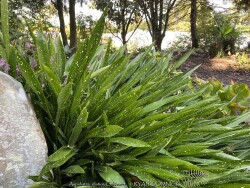

Cast-iron Plant (Aspidistra sp.) is a beautiful perennial and warmer climates for full shade. The leaves are glossy green perched on narrow stems with fat leaf blades. Unfortunately in our zone 6 Kansas climate, they cannot reliably be used as a perennial here. Most broadleaf evergreen plants are difficult to push the envelope with colder zones because evergreen leaves are more expensive to replace than for deciduous plants (slower and requires more energy from the plant). As a potted patio plant for full shade, they are wonderful. Grown in a raised pot, they are hardy to about 15-20° so you may be able to miss the first few frosts when moving them in for the winter. Before extreme cold (lower than 10 degrees F), they must be moved and overwintered in a dark garage or basement with monthly watering or bright window as a winter-only houseplant. Either way, they will hold up very well in the winter and maintain attractive foliage. When grown as a permanent house plant, they will last many years is grown in a bright indirect area. When Cast-iron Plant is grown as a permanent houseplant, you will need to watch for spider mites and possibly scale after a few years. Taking the whole plant outside and spraying with water a few times a year will help. Spider mites thrive and dry dusty conditions with low humidity (such as your house). Overall, Cast-iron Plants are very easy to grow hence their name. They will tolerate lower light than just about any house plant but after a few years, even this plant will decline unless given a summer growing season under a shaded tree or brighter conditions inside the house. New leaves grow about once per year and gradually the plant will need to be repotted as it is possible for them to split the container. This is a great time to divide the root system and get several new plants. This is one of our all-time favorite house plants.
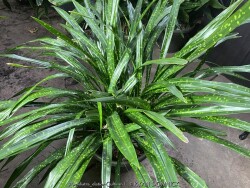

Cast-iron Plant (Aspidistra sp.) is a beautiful perennial and warmer climates for full shade. The leaves are glossy green perched on narrow stems with fat leaf blades. Unfortunately in our zone 6 Kansas climate, they cannot reliably be used as a perennial here. Most broadleaf evergreen plants are difficult to push the envelope with colder zones because evergreen leaves are more expensive to replace than for deciduous plants (slower and requires more energy from the plant). As a potted patio plant for full shade, they are wonderful. Grown in a raised pot, they are hardy to about 20-25° so you may be able to miss the first few frosts when moving them in for the winter. Before extreme cold (lower than approx.15 degrees F), they must be moved and overwintered in a dark garage or basement with monthly watering or bright window as a winter-only houseplant. Either way, they will hold up very well in the winter and maintain attractive foliage. When grown as a permanent house plant, they will last many years is grown in a bright indirect area. When Cast-iron Plant is grown as a permanent houseplant, you will need to watch for spider mites and possibly scale after a few years. Taking the whole plant outside and spraying with water a few times a year will help. Spider mites thrive and dry dusty conditions with low humidity (such as your house). Overall, Cast-iron Plants are very easy to grow hence their name. They will tolerate lower light than just about any house plant but after a few years, even this plant will decline unless given a summer growing season under a shaded tree or brighter conditions inside the house. New leaves grow about once per year and gradually the plant will need to be repotted as it is possible for them to split the container. This is a great time to divide the root system and get several new plants. This is one of our all-time favorite house plants.
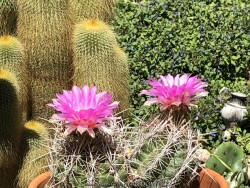

Succulents are usually spineless and grown for their beautiful shapes, color and texture. Cacti are known for their spines, unusual shapes and beautiful flowers. Both succulents and cacti store water in their fleshy tissues. And can survive long periods without water. Cacti and succulents are usually grown as a deck/patio plant or house plant in Kansas. Grow in full sun with little to no extra watering except that which comes from rainfall. Generally, plants may be brought out in Late May through Early October in our zone 6a Lawrence, KS climate. To play is safe, potted plants are best moved in before autumn leaves begin to drop and before night temperatures get below 45 degrees F. It is very important to avoid the combination of wet and cold. Move to a bright interior window over the winter with little to no watering and keep above 50 degrees F. As a winter house plant, it will look presentable all winter long with little to no waterings. As a permanent house plant, provide bright light and allow the soil to dry completely between waterings and you will get many years of carefree enjoyment. Plants grown permanently indoors may eventually begin to elongate stretching for light and lose their spine color. It can be hard to reproduce the intense UV sunlight they need when growing indoors so moving outside for the summer is best. Generally if moving outside for the summer, allow 1-2 weeks of part shade or morning sun before placing in full sun. Plants with time to acclimate will thrive in full sun but be careful not to rush it or sunburning may occur. Repotting may or may not be needed depending on how large you want the plant to grow; plants can continue to grow taller and tolerate extremely root-bound pots but may need wind bracing. If repotting, make sure to use a sharp draining low organic cactus mix with plenty of sand and perlite but avoid peat moss. The “soil” most commercial cacti are potted in to too peaty and light weight. This soil becomes hydrophobic and shrinks after becoming bone dry and difficult to re wet again. Cacti never grow in peat-based soils in nature; this “Soil” is only good for shipping because of the light weight. Potted plants are very low maintenance but watch for scale and mealybugs that may hide beneath the cover of spines. The best pest removal approach is to periodically wash the cactus off. Achieve this with a water nozzle or hose breaker turned mostly off to increase the pressure from the blast of water. This high-pressured water kills the pests without damaging the thick cactus skin. Here are some little-known or rare factoids about cacti: 1. The "spines" are actually modified leaves filled with sap at first, then quickly drying out to form the spines! 2. Many cacti have bright colored flowers that mainly attract bees, while some tubular flowering types attract hummingbirds and bats. 3. Late on the evolutionary timeline, cacti fossils are rare to non-existent. Cacti are native almost exclusively to the Americas, while succulents can include a much larger plant palette be from any dry area in the world. 4. Some cactus plants have been known to survive more than 2 years without water. 5. Some cacti first evolved in a dry climate that later became wetter again. For example: several jungle species live as epiphytes in trees to achieve the fast drainage they need.
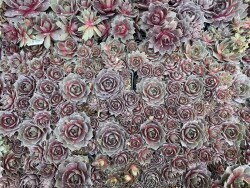

These tiny perennials and succulents produce various colored mats of foliage. In favorable conditions they can spread by runners rooting as they go; several species are valued in cultivation as groundcover for dry, sunny locations. Grow these in a rock garden, in cracks between rocks, or on top of or in a retaining wall. You may also grow in flat areas like in between stepping stones provided you used a gravelly or sandy base for the stones. Most rock garden plants will not tolerate rich moist soils as other plants or weeds will shade it out. Crown rot can occur during lengthy hot humid summer rainy periods. Most rock garden plants do not thrive indoors; aphids and spider mites seem to find them after a few months but overwintering indoors in a cool environment may work. If grown in pots and kept on the dry side, you may leave out all winter allowing to freeze solid; plants will go dormant and resume growth in the spring.
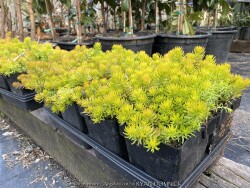

These tiny perennials and succulents produce various colored mats of foliage. In favorable conditions they can spread by runners rooting as they go; several species are valued in cultivation as groundcover for dry, sunny locations. Grow these in a rock garden, in cracks between rocks, or on top of or in a retaining wall. You may also grow in flat areas like in between stepping stones provided you used a gravelly or sandy base for the stones. Most rock garden plants will not tolerate rich moist soils as other plants or weeds will shade it out. Crown rot can occur during lengthy hot humid summer rainy periods. Most rock garden plants do not thrive indoors; aphids and spider mites seem to find them after a few months but overwintering indoors in a cool environment may work. If grown in pots and kept on the dry side, you may leave out all winter allowing to freeze solid; plants will go dormant and resume growth in the spring.


Succulents are usually spineless and grown for their beautiful shapes, color and texture. Cactus are known for their spines, unusual shapes and beautiful flowers. Late on the evolutionary timeline, cacti fossils are rare to non-existent. The "spines" are actually modified leaves! Cacti are native almost exclusively to the Americas, while succulents can include a much larger plant palette be from any dry area in the world. Both succulents and cacti store water in their fleshy tissues. They are usually grown as a patio or house plant in Kansas. In the wild, some species are hardy to below 0 degrees F. Grow in full sun with no extra watering except that which comes from rainfall. Repotting may or may not be needed depending on how large you want the plant to grow; plants can continue to grow taller and tolerate extremely root-bound pots but may need wind bracing. If repotting, make sure to use a sharp draining low organic cactus mix with plenty of sand and perlite. To play is safe, potted plants are best moved in before night temperatures get below 45 degrees F. It is important to avoid the combination of wet and cold. Move to a bright interior window over the winter with no watering and keep above freezing. As a winter house plant, it will look presentable all winter long with just no waterings. As a permanent house plant, provide bright light and allow the soil to dry between waterings for many years of carefree enjoyment. Plants grown permanently indoors may begin to elongate stretching for light and lose their spine color. It can be hard to reproduce the intense UV sunlight they need so moving outside for the summer is best. Generally if moving outside for the summer, allow 1-2 weeks of part shade or morning sun before placing in full sun. Plants with time to acclimate will thrive in full sun but be careful not to rush it or sunburning will occur. Potted plants are very low maintenance but watch for scale and mealybugs that may hide beneath the cover of spines. Some species grow well in hanging baskets!
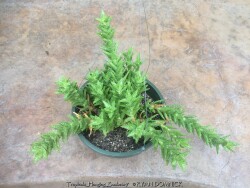

***Description for this plant available with future update!***


***Description for this plant available with future update!*** Cacti are known for their spines, unusual shapes and beautiful flowers. Both succulents and cacti store water in their fleshy tissues. And can survive long periods without water. Cacti and succulents are usually grown as a deck/patio plant or house plant in Kansas. Grow in full sun with little to no extra watering except that which comes from rainfall. Generally, plants may be brought out in Late May through Early October in our zone 6a Lawrence, KS climate. To play is safe, potted plants are best moved in before autumn leaves begin to drop and before night temperatures get below 45 degrees F. It is very important to avoid the combination of wet and cold. Move to a bright interior window over the winter with little to no watering and keep above 50 degrees F. As a winter house plant, it will look presentable all winter long with little to no waterings. As a permanent house plant, provide bright light and allow the soil to dry completely between waterings and you will get many years of carefree enjoyment. Plants grown permanently indoors may eventually begin to elongate stretching for light and lose their spine color. It can be hard to reproduce the intense UV sunlight they need when growing indoors so moving outside for the summer is best. Generally if moving outside for the summer, allow 1-2 weeks of part shade or morning sun before placing in full sun. Plants with time to acclimate will thrive in full sun but be careful not to rush it or sunburning may occur. Repotting may or may not be needed depending on how large you want the plant to grow; plants can continue to grow taller and tolerate extremely root-bound pots but may need wind bracing. If repotting, make sure to use a sharp draining low organic cactus mix with plenty of sand and perlite but avoid peat moss. The “soil” most commercial cacti are potted in to too peaty and light weight. This soil becomes hydrophobic and shrinks after becoming bone dry and difficult to re wet again. Cacti never grow in peat-based soils in nature; this “Soil” is only good for shipping because of the light weight. Potted plants are very low maintenance but watch for scale and mealybugs that may hide beneath the cover of spines. The best pest removal approach is to periodically wash the cactus off. Achieve this with a water nozzle or hose breaker turned mostly off to increase the pressure from the blast of water. This high-pressured water kills the pests without damaging the thick cactus skin. Here are some little-known or rare factoids about cacti: 1. The "spines" are actually modified leaves filled with sap at first, then quickly drying out to form the spines! 2. Many cacti have bright colored flowers that mainly attract bees, while some tubular flowering types attract hummingbirds and bats. 3. Late on the evolutionary timeline, cacti fossils are rare to non-existent. Cacti are native almost exclusively to the Americas, while succulents can include a much larger plant palette be from any dry area in the world. 4. Some cactus plants have been known to survive more than 2 years without water. 5. Some cacti first evolved in a dry climate that later became wetter again. For example: several jungle species live as epiphytes in trees to achieve the fast drainage they need.
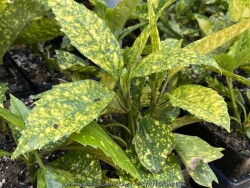

Japanese Aucuba (Aucuba japonica) is a surprisingly hardy evergreen shrub from Japan featuring dark green leaves with gold spots. Flowering and fruiting may occur in warmer climates but have not witnessed that in our zone 6a climate. Aucuba is at the northern edge of its range but will survive and reach varying heights of 1 to 3 feet. Winterkill occurs at about -5 to -10° so plan to prune off winter kill and new growth will resume in spring. In southern zones with mild winters aucuba can reach 6-8' tall, tolerating full shade and drought making it a great dry shade plant. In our Lawrence Gardens, this is possible if sited on a south exposure in full shade with winter wind protection. Rich organic soils and morning sun / filtered sun are both preferred in northern climates. Watering during the winter when dry will help broadleaf evergreen shrubs stay hydrated and maintain their winter foliage better. This jewel of the shade garden adds valuable bright green and yellow winter color giving some structure. Combine with other shade plants such as hosta, Solomon Seal, Hellebore, Barrenwort, or Coralberry. Plants in our Lawrence, KS gardens generally survive for several years and are worth the effort in the shade garden. Don't count on them getting very big so plant close together if designing with a grouping. Aucuba japonica 'Gold King' is a male form with numerous gold spots on dark green leaves.
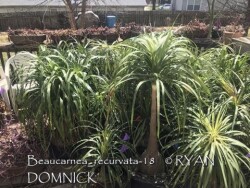

Ponytail Palm / Elephant's Foot (Beaucarnea recurvata) has a pronounced swollen caudex (trunk) and attractive green grass-like curved foliage making an excellent architectural statement. Ponytail Palm (not a true palm) is native to low deciduous forests and semi-desert areas of southeastern Mexico, Belize and Guatemala where it typically grows to as much as 30' tall. It is best used as a houseplant or summer patio plant in Kansas. Place in full sun to part sun with optional extra watering including that which comes from rainfall. Repotting may or may not be needed depending on how large you want the plant to grow; plants can continue to grow taller and tolerate extremely root-bound pots but may need wind bracing. in Potted plants are hardy to at least 25 degrees F for a short time if kept dry so you are ok if you miss the first light frost. Do not allow the pot with rootball to freeze solid though. Move into a cold garage, basement, or bright window over the winter with occasional to no watering. Larger ponytail palms can survive 6-8 months without water in the winter if allowed to have a healthy outdoor growing season. As a winter house plant, it will look presentable all winter long with just a couple waterings.(also to prevent lanky winter growth) As a permanent house plant, provide bright light and allow the soil to dry between waterings for many years (even decades) of carefree enjoyment. Potted plants grow very slow and are very low maintenance needing only old leaves trimmed once per year. Mealy bugs can be a problem with permanent indoor house plants but will go away if grown outside during the summer or never introduced in the first place. Either way, sharp blasts of hose water and/or horticultural oil spray will mostly eliminate this (only) pest problem.
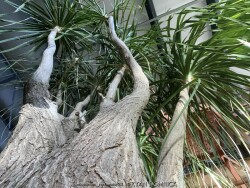

Ponytail Palm / Elephant's Foot (Beaucarnea recurvata) has a pronounced swollen caudex (trunk) and attractive green grass-like curved foliage making an excellent architectural statement. Ponytail Palm (not a true palm) is native to low deciduous forests and semi-desert areas of southeastern Mexico, Belize and Guatemala where it typically grows to as much as 30' tall. It is best used as a houseplant or summer patio plant in Kansas. Place in full sun to part sun with optional extra watering including that which comes from rainfall. Repotting may or may not be needed depending on how large you want the plant to grow; plants can continue to grow taller and tolerate extremely root-bound pots but may need wind bracing. in Potted plants are hardy to at least 25 degrees F for a short time if kept dry so you are ok if you miss the first light frost. Do not allow the pot with rootball to freeze solid though. Move into a cold garage, basement, or bright window over the winter with occasional to no watering. Larger ponytail palms can survive 6-8 months without water in the winter if allowed to have a healthy outdoor growing season. As a winter house plant, it will look presentable all winter long with just a couple waterings.(also to prevent lanky winter growth) As a permanent house plant, provide bright light and allow the soil to dry between waterings for many years (even decades) of carefree enjoyment. Potted plants grow very slow and are very low maintenance needing only old leaves trimmed once per year. Mealy bugs can be a problem with permanent indoor house plants but will go away if grown outside during the summer or never introduced in the first place. Either way, sharp blasts of hose water and/or horticultural oil spray will mostly eliminate this (only) pest problem.
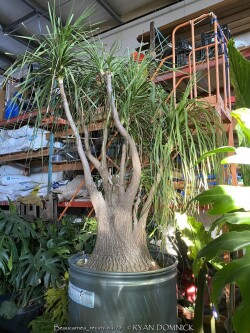

Ponytail Palm / Elephant's Foot (Beaucarnea recurvata) has a pronounced swollen caudex (trunk) and attractive green grass-like curved foliage making an excellent architectural statement. Ponytail Palm (not a true palm) is native to low deciduous forests and semi-desert areas of southeastern Mexico, Belize and Guatemala where it typically grows to as much as 30' tall. It is best used as a houseplant or summer patio plant in Kansas. Place in full sun to part sun with optional extra watering including that which comes from rainfall. Repotting may or may not be needed depending on how large you want the plant to grow; plants can continue to grow taller and tolerate extremely root-bound pots but may need wind bracing. in Potted plants are hardy to at least 25 degrees F for a short time if kept dry so you are ok if you miss the first light frost. Do not allow the pot with rootball to freeze solid though. Move into a cold garage, basement, or bright window over the winter with occasional to no watering. Larger ponytail palms can survive 6-8 months without water in the winter if allowed to have a healthy outdoor growing season. As a winter house plant, it will look presentable all winter long with just a couple waterings.(also to prevent lanky winter growth) As a permanent house plant, provide bright light and allow the soil to dry between waterings for many years (even decades) of carefree enjoyment. Potted plants grow very slow and are very low maintenance needing only old leaves trimmed once per year. Mealy bugs can be a problem with permanent indoor house plants but will go away if grown outside during the summer or never introduced in the first place. Either way, sharp blasts of hose water and/or horticultural oil spray will mostly eliminate this (only) pest problem.
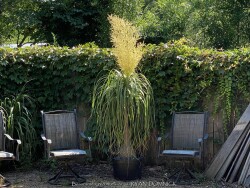

Ponytail Palm / Elephant's Foot (Beaucarnea recurvata) has a pronounced swollen caudex (trunk) and attractive green grass-like curved foliage making an excellent architectural statement. Ponytail Palm (not a true palm) is native to low deciduous forests and semi-desert areas of southeastern Mexico, Belize and Guatemala where it typically grows to as much as 30' tall. It is best used as a houseplant or summer patio plant in Kansas. Place in full sun to part sun with optional extra watering including that which comes from rainfall. Repotting may or may not be needed depending on how large you want the plant to grow; plants can continue to grow taller and tolerate extremely root-bound pots but may need wind bracing. in Potted plants are hardy to at least 25 degrees F for a short time if kept dry so you are ok if you miss the first light frost. Do not allow the pot with rootball to freeze solid though. Move into a cold garage, basement, or bright window over the winter with occasional to no watering. Larger ponytail palms can survive 6-8 months without water in the winter if allowed to have a healthy outdoor growing season. As a winter house plant, it will look presentable all winter long with just a couple waterings.(also to prevent lanky winter growth) As a permanent house plant, provide bright light and allow the soil to dry between waterings for many years (even decades) of carefree enjoyment. Potted plants grow very slow and are very low maintenance needing only old leaves trimmed once per year. Mealy bugs can be a problem with permanent indoor house plants but will go away if grown outside during the summer or never introduced in the first place. Either way, sharp blasts of hose water and/or horticultural oil spray will mostly eliminate this (only) pest problem.


Ponytail Palm / Elephant's Foot (Beaucarnea recurvata) has a pronounced swollen caudex (trunk) and attractive green grass-like curved foliage making an excellent architectural statement. Ponytail Palm (not a true palm) is native to low deciduous forests and semi-desert areas of southeastern Mexico, Belize and Guatemala where it typically grows to as much as 30' tall. It is best used as a houseplant or summer patio plant in Kansas. Place in full sun to part sun with optional extra watering including that which comes from rainfall. Repotting may or may not be needed depending on how large you want the plant to grow; plants can continue to grow taller and tolerate extremely root-bound pots but may need wind bracing. in Potted plants are hardy to at least 25 degrees F for a short time if kept dry so you are ok if you miss the first light frost. Do not allow the pot with rootball to freeze solid though. Move into a cold garage, basement, or bright window over the winter with occasional to no watering. Larger ponytail palms can survive 6-8 months without water in the winter if allowed to have a healthy outdoor growing season. As a winter house plant, it will look presentable all winter long with just a couple waterings.(also to prevent lanky winter growth) As a permanent house plant, provide bright light and allow the soil to dry between waterings for many years (even decades) of carefree enjoyment. Potted plants grow very slow and are very low maintenance needing only old leaves trimmed once per year. Mealy bugs can be a problem with permanent indoor house plants but will go away if grown outside during the summer or never introduced in the first place. Either way, sharp blasts of hose water and/or horticultural oil spray will mostly eliminate this (only) pest problem.
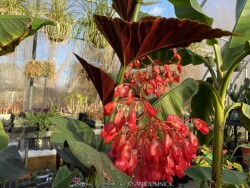

***Description for this plant available with future update!***Angel Wing Begonia (Tropical), is also known as Begonia x coralline